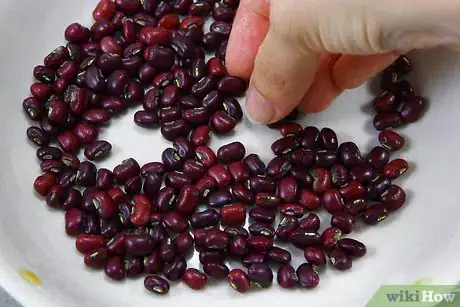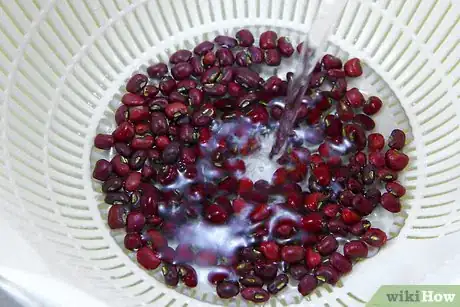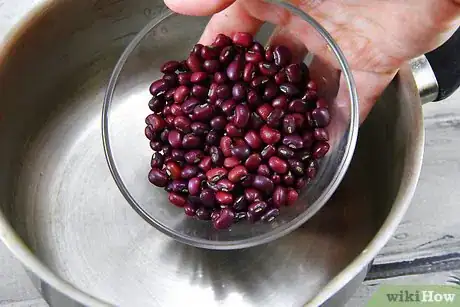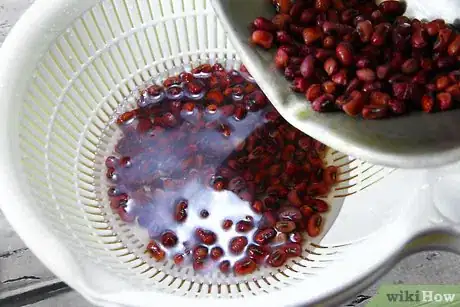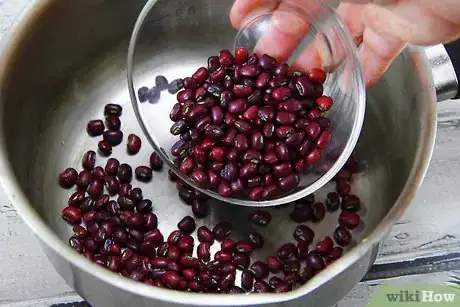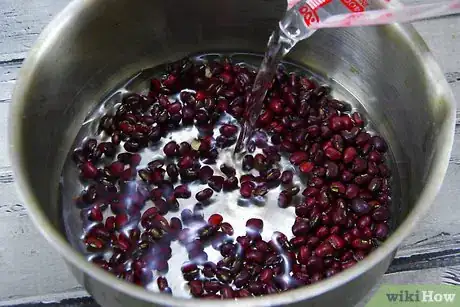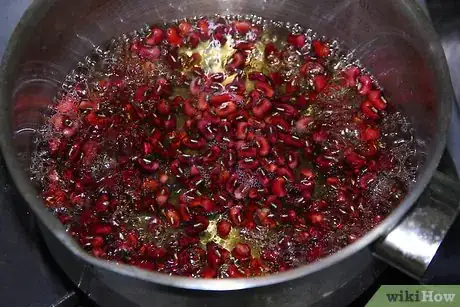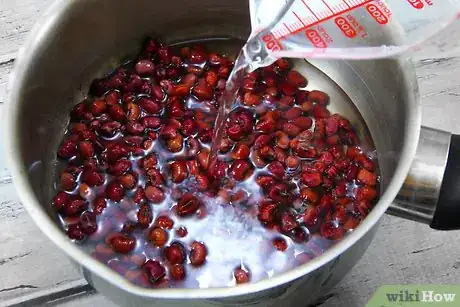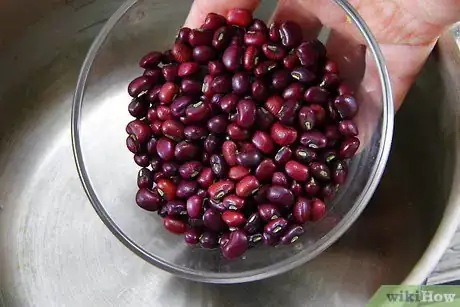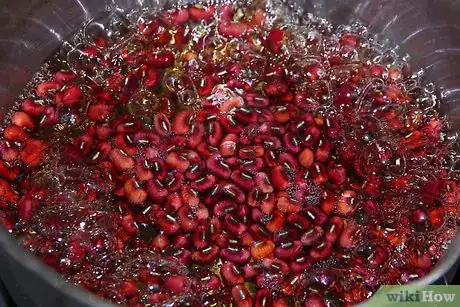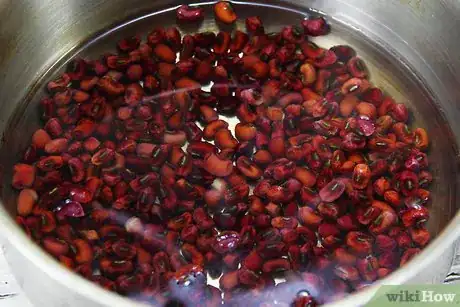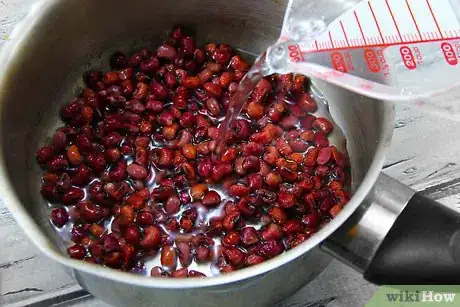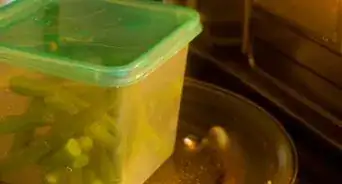This article was co-authored by wikiHow Staff. Our trained team of editors and researchers validate articles for accuracy and comprehensiveness. wikiHow's Content Management Team carefully monitors the work from our editorial staff to ensure that each article is backed by trusted research and meets our high quality standards.
There are 12 references cited in this article, which can be found at the bottom of the page.
This article has been viewed 25,078 times.
Learn more...
Before you can cook with dried beans, it’s necessary to soak them. A thorough soak softens the beans and helps them heat more evenly, while also washing away starches that can cause gas and other uncomfortable digestive issues. All you’ll need is a bag of raw beans, a spacious pot and few cups of water. You can then decide on a soaking method—quick, hot or the traditional overnight way—that best fits your timetable and the type of dish you’re preparing.
Steps
Using a Traditional Soak
-
1Check the beans for rocks. Pour the beans onto a large, flat baking sheet and spread them out until they’re distributed across the entire surface. Sift through the beans by hand and pick out any foreign object you find. No amount of soaking will soften a rock![1]
- Since beans grow in the ground, it’s not uncommon for them to contain small stones or other debris.
- Rocks will usually be easy to spot, as they’re colorless and tend to be smaller than most kinds of beans.[2]
-
2Rinse the beans. Transfer the beans to a colander and run them under a stream of cool water, tossing or stirring them by hand occasionally. A quick trip under the faucet will help wash away any traces of dirt that happen to be clinging to the bean. Continue rinsing the beans until the water runs clear.[3]
- Some cooks may choose to skip this step since soaking the beans also serves to wash them, but a preliminary rinse will result in a cleaner bean.
Advertisement -
3Place the beans in a large pot or bowl and add water. Fill the pot until the beans are completely submerged—there should be about 1–2 inches (3–5 cm) of water above the uppermost layer. Use cool or lukewarm water only, not cold.[4]
- Unless you’re preparing them in bulk, it will be easiest to soak all of your beans at once. Breaking them up into multiple batches can be quite time-consuming.
- Beans expand as they absorb moisture, so make sure you choose a container that’s large enough to account for any changes in size.[5]
-
4Soak the beans overnight. Cover the beans and let them sit for at least 8 hours. For extra soft beans, you can soak them for as long as 24 hours. The longer the soak, the more indigestible sugars will leach out of the beans.[6]
- Softer types of beans like lentils and chickpeas may only need to spend a few hours in water, whereas hard-shelled varieties like black beans will benefit from a longer soak.[7]
- If you’re running out of countertop space, make room for the bowl or pot in the refrigerator.
-
5Drain and rinse the beans. Once you’re satisfied with the amount of soaking the beans have done, uncover them and pour out the water (you’ll likely notice that it’s turned a dingy color). Give the beans another quick rinse, then refill the pot with fresh water to begin cooking them.[8]
- A traditional soak is useful for when you have plenty of time on your hands, or if you’d rather take care of your prep work in advance and save time putting together the finished meal.
- Never use the same water to cook as you did to soak. This will just reintroduce the same dirt and starchy byproducts back into the beans.
Using a Quick Soak
-
1Place the beans in a large pot. You’ll be using direct heat to soak the beans for this method, so skip the bowls and other containers and go straight for a spacious piece of cookware that’s safe for the stovetop. A stockpot will work best in most cases. You might also use a smaller saucepan if you’re only preparing enough for a single serving.
- Don’t forget to sort and rinse the beans before you get started.
- There should be enough room in whatever pot you select to boil several cups of water.
-
2Add enough water to cover the beans. The water should sit a couple inches above the beans at the top of the heap. It’s a good idea to use slightly more water than you would for a cold soak, since some of it will evaporate during the boiling process.[9]
- For a more exact measurement, a good rule of thumb is to use about 6 cups of water for every 2 cups of beans you’re serving.
-
3Bring the beans to a boil for 1-2 minutes. Set the cooktop to medium-high heat and warm the pot uncovered until the water just begins to bubble. After a couple of minutes have elapsed, turn off the cooktop and remove the beans from the heat.[10]
- Stir the beans periodically as they boil to keep them circulating.
- This first quick boil will begin breaking down the waxy shell of the beans, which can significantly reduce the amount time it takes to cook them.
-
4Allow the beans to soak for one hour. Keep the beans covered while they sit to lock in the heat. Set a timer to help you remember to check on the beans when their time is up.[11]
- Situate the pot on one of the back burners where it won’t be bumped into or knocked over accidentally.
- Quick soaking is the fastest way to prepare dried beans from scratch, and can come in handy when you’re whipping up dinner in a pinch.
-
5Refill the pot with fresh water. Once the pot has cooled off, drain the soaking water and add clean water for cooking. You can then cook the beans to desired tenderness and use them in your favorite recipes or store them to reheat later.[12]
- Adding a splash of mild acid like vinegar or fresh-squeezed lemon juice can help large, tough beans cook more evenly.[13]
Using a Hot Soak
-
1Pour the beans into a pot. Once you’ve picked through the beans and rinsed them off, move them to a deep lidded pot. Make sure there’s enough space for the quantity of beans you’re preparing and the water to soak them in, along with a little extra room for the water to rise as it heats up.
- As with the quick soak method, you’ll be doing both your soaking and cooking in the same piece of cookware.
-
2Fill the pot with water. Use about 10 cups for every 2 cups of beans. For a hot soak, you’ll need to add slightly more water than you would for a quick or traditional soak. This will prevent too much moisture from escaping while the beans are being heated.[14]
- Avoid overfilling the pot, or it may bubble over once it begins boiling.
-
3Boil the beans for 2-3 minutes. Leave the beans uncovered and be sure to stir them periodically to keep them from sticking. You should notice a thick foam forming over the boiling beans—this is evidence that the tough starches are cooking out.[15]
- If the water level in the beans looks low by the time they finish boiling, you can add more half a cup at a time.
-
4Let the beans soak for 2-4 hours. Set aside some room on the cooktop or kitchen counter to leave the pot. With a hot soak, you stand to make up for the additional time the beans spend soaking with a much faster cook time.[16]
- Hot soaking is the most effective method of preparation for people who want consistently tender beans.
- A longer soak in hot water can cut down on the bloat-causing byproducts in the beans by up to 80%.
-
5Prepare the beans for cooking. Dump out the dirty soaking water and replace it with an equal amount of clean water. Add salt, black pepper, oregano, diced onion or any other seasonings of choice and simmer the beans until they reach the desired texture.[17]
- Hot soak beans that are destined for soups and salads to ensure that they turn out nice and soft.
- A perfectly cooked bean should be firm on the outside and fluffy in the middle, with the skin intact.
Things You'll Need
- Bag of dried beans
- Large lidded pot or bowl
- Fresh water
- Wooded spoon
- Vinegar or lemon juice (optional)
- Salt, black pepper and other spices (optional)
References
- ↑ https://www.youtube.com/watch?v=xu8mjNARsAY
- ↑ http://simpledailyrecipes.com/102104/sort-dry-beans/
- ↑ http://www.usdrybeans.com/health-nutrition/cooking-with-beans/
- ↑ http://toriavey.com/how-to/2017/03/how-to-soak-cook-and-freeze-dried-black-beans/
- ↑ https://www.youtube.com/watch?v=xu8mjNARsAY
- ↑ https://www.thehealthyhomeeconomist.com/why-you-must-soak-your-beans/
- ↑ http://www.squawkfox.com/how-to-soak-and-cook-dried-beans/
- ↑ http://beaninstitute.com/the-traditional-four-step-method/
- ↑ https://www.thekitchn.com/how-to-quicksoak-dried-beans-cooking-lessons-from-the-kitchn-198610
- ↑ http://www.bonappetit.com/test-kitchen/cooking-tips/article/the-faster-way-to-soak-beans-for-cooking
- ↑ http://toriavey.com/how-to/2017/03/how-to-soak-cook-and-freeze-dried-black-beans/
- ↑ https://www.youtube.com/watch?v=xu8mjNARsAY
- ↑ http://dontwastethecrumbs.com/2014/10/how-to-soak-and-cook-beans-from-scratch/
- ↑ http://food.unl.edu/cooking-dry-beans-scratch-can-be-quick
- ↑ http://beaninstitute.com/the-traditional-four-step-method/
- ↑ http://www.squawkfox.com/how-to-soak-and-cook-dried-beans/
- ↑ http://www.seriouseats.com/2016/10/beans-legumes-pulses-varieties-recipes-cooking-tips.html
About This Article
To soak beans, transfer them to a colander and rinse them thoroughly with water, taking care to remove any tiny rocks or debris that you see. Place the rinsed beans in a large pot or bowl and add lukewarm water until the beans are fully submerged. Then, cover the beans and let them soak at room temperature for at least 8 hours. Once the beans have softened, put a colander in your sink and pour the beans and water into it. Give your beans a thorough rinse with fresh water and they're ready to cook. If you want to learn how to soak your beans quickly, keep reading!
